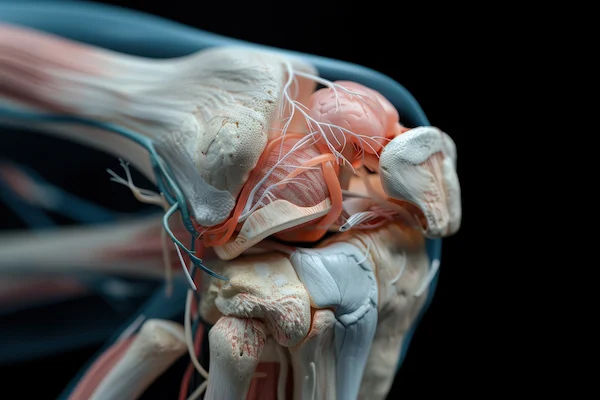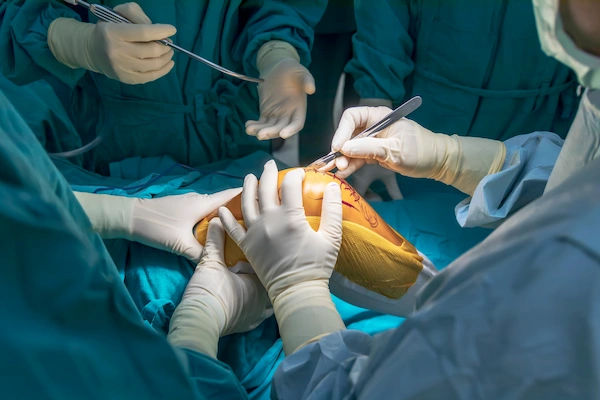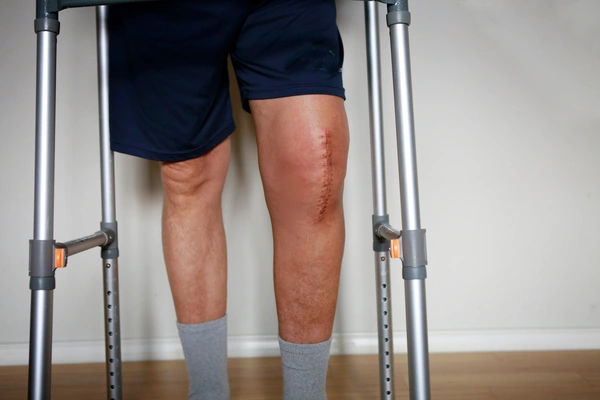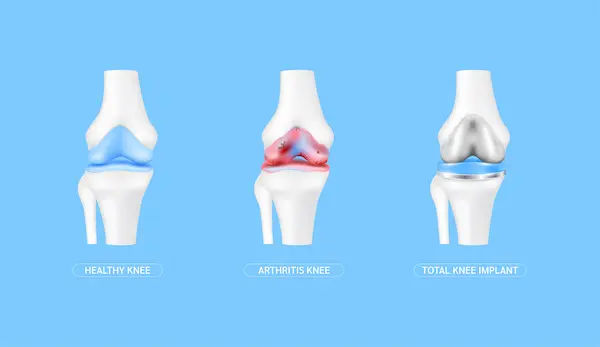The Ultimate Guide to Robotic Knee Replacement Surgery
Discover the benefits of robotic knee replacement surgery, including precise implant placement, faster recovery, and reduced pain. Learn how robotic-assisted procedures improve outcomes and help you regain mobility and a pain-free life.

Written by Dr. Dhankecha Mayank Dineshbhai
Reviewed by Dr. Md Yusuf Shareef MBBS
Last updated on 7th Oct, 2025
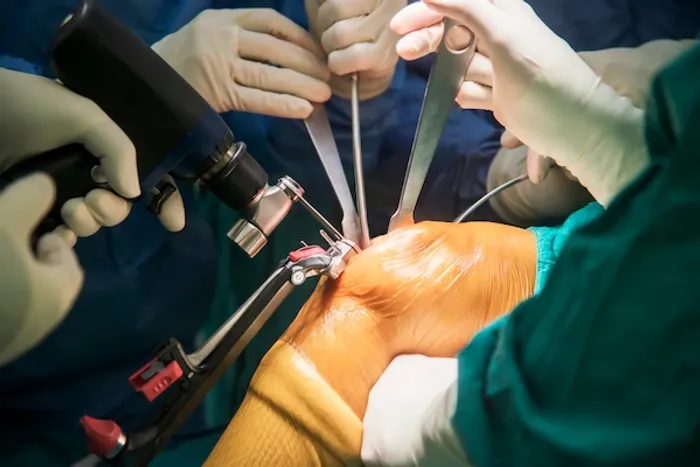
For millions suffering from chronic knee pain due to arthritis or injury, the thought of knee replacement surgery can be daunting. Visions of large incisions, prolonged pain, and a long, difficult recovery often come to mind. But what if technology could change that narrative? Enter robotic knee replacement—a revolutionary approach that is transforming patient experiences and outcomes. This guide will demystify this advanced procedure, explaining how it works, its profound benefits over traditional methods, and what you can realistically expect from consultation to full recovery. If you're contemplating a future with less pain and more mobility, understanding the role of robotics is your first step toward making an informed decision.
What is Robotic Knee Replacement? Beyond Science Fiction
Robotic knee replacement isn't about a robot autonomously performing surgery while the surgeon sips coffee in the corner. Rather, it's an advanced form of computer-assisted surgery where the orthopaedic surgeon uses a robotic system as a high-precision tool to execute their personalised surgical plan with unparalleled accuracy. Think of it like a super-powered GPS for your knee: the surgeon still drives the car, but the GPS ensures they take the absolute best route, avoiding detours and pitfalls.
The Surgeon is Still in Charge: Your Guide to the Human-Robot Partnership
The core principle of this technology is surgeon control. The robotic system has no artificial intelligence or pre-programmed instructions to operate on its own. It acts on the specific commands of the surgeon, enhancing their skill and experience. The system provides real-time data and physical guidance, allowing the surgeon to prepare the bone and position the implant with a level of precision that is difficult to achieve with the human hand alone. This partnership minimises human variability, leading to consistently superior results.
Meet the Robots: A Look at Common Systems like Mako and ROSA
Several robotic systems are FDA-approved and widely used today. The Mako System by Stryker is one of the most recognised, often used for both partial and total knee replacements. Another leading system is the ROSA Knee System by Zimmer Biomet. While each has unique features, they share a common goal: to translate the surgeon’s plan into action with extreme accuracy. These systems often incorporate "haptic feedback," which creates a virtual boundary—if the surgeon's tool moves outside the planned surgical area, the robotic arm resists or stops, protecting surrounding healthy tissue.
Consult Top Specialists Here
How Robotic Knee Surgery Works: A Step-by-Step Journey
Understanding the process can alleviate much of the anxiety associated with surgery. The robotic assisted knee surgery procedure is a meticulously planned journey, not a single event.
Phase 1: Meticulous Pre-Surgical Planning with 3D Modelling
Long before you enter the operating room, the surgical plan is crafted. A CT scan of your knee is taken, which is used to create a unique, detailed 3D virtual model of your joint. Using this model, your surgeon can precisely determine the optimal size, positioning, and alignment of the knee implant specific to your anatomy. This patient-specific plan is the blueprint that the robot will follow during the operation, ensuring a custom fit rather than a one-size-fits-all approach.
Phase 2: The Day of Surgery: Precision in Action
On surgery day, the plan springs to life. The surgeon makes a small incision and prepares the bone surfaces. The robotic system, equipped with cameras and sensors, tracks the exact position of your bones and the surgical instruments in real-time. The surgeon guides the robotic arm, which assists in removing arthritic bone and cartilage with exceptional accuracy. The system’s feedback ensures the bone cuts and implant placement match the pre-operative plan perfectly, optimizing implant alignment and preserving healthy bone and soft tissue.
Robotic vs. Traditional Knee Replacement: A Clear-Cut Comparison
The differences between these two approaches are significant and directly impact your recovery and long-term satisfaction.
Precision and Accuracy: The Key to a Better-Fitting Implant
Traditional surgery relies heavily on the surgeon’s eye, experience, and manual instruments. While skilled surgeons achieve excellent results, the margin for error, though small, exists. Robotic surgery quantifiably improves precision. Studies show that robotic assistance leads to more accurate implant positioning and better ligament balancing—a critical factor for how natural your new knee will feel. A well-balanced knee is less likely to feel "artificial" and can lead to a more normal gait.
Tissue Sparing: Why Smaller Incisions and Less Trauma Matter
Because the robotic system provides such precise guidance, the surgeon can often perform the surgery through a smaller incision and with minimal disruption to the surrounding muscles, ligaments, and tendons. This minimally invasive approach is a primary reason why patients experience less blood loss, less post-operative pain, and significantly reduced swelling compared to traditional surgery.
The Tangible Benefits of Choosing a Robotic-Assisted Procedure
The enhanced precision and tissue-sparing nature of the robotic technique translate into direct, measurable benefits for you, the patient.
A Smoother Recovery: Less Pain, Quicker Hospital Discharge
This is often the most appreciated benefit. Patients typically report requiring less pain medication. Due to reduced trauma, many can start walking and bending their knee sooner after surgery. This often leads to a shorter hospital stay—sometimes just one night—and a faster transition to outpatient physical therapy. The recovery time for robotic knee surgery is generally smoother and more rapid in the initial stages.
The Long-Term Payoff: Improved Implant Longevity and Function
A perfectly positioned and balanced knee implant experiences more even wear and stress. This can potentially increase the longevity of the implant, reducing the risk of premature loosening and the need for revision surgery down the line. Furthermore, the improved alignment and soft-tissue balance often result in a better range of motion and a more natural-feeling knee, allowing you to return to an active lifestyle with greater confidence.
Are You a Candidate for Robotic Knee Replacement?
Ideal Candidates: From Arthritis Sufferers to Active Individuals
Most people who are candidates for traditional knee replacement are also candidates for the robotic procedure. It is particularly beneficial for individuals with osteoarthritis, rheumatoid arthritis, or post-traumatic arthritis whose pain has not responded to conservative treatments like medication, injections, or physical therapy. Active individuals seeking the quickest and most optimal recovery often seek out this technology.
Important Considerations: Weight, Bone Quality, and Overall Health
As with any surgery, overall health is a factor. Severe obesity, very poor bone quality (osteoporosis), or certain active infections may complicate any joint replacement procedure. A thorough evaluation by an orthopaedic surgeon is essential. If you are experiencing persistent knee pain that limits your daily activities, consulting an orthopaedic specialist from Apollo 24|7 can help you determine if you are a suitable candidate and discuss the best options for your specific situation.
What to Expect: Your Roadmap to Recovery
Here’s what to expect on your recovery journey:
The First 24-48 Hours: Pain Management and Early Movement
You will be up and walking with assistance within hours of surgery. The focus is on managing pain with medication and beginning gentle exercises to prevent blood clots and stimulate circulation.
The First 6 Weeks: Physical Therapy and Regaining Strength
This is the most critical phase. You will work with a physical therapist to restore strength, flexibility, and range of motion. Most people can walk without a cane or walker within 3-4 weeks.
Long-Term Goals: Returning to the Activities You Love
By three months, most patients have resumed low-impact activities like walking, swimming, and cycling. Full recovery and the feeling of a "normal" knee can take up to a year, but the dramatic improvement in quality of life is felt much sooner.
Addressing Common Concerns: Cost, Safety, and Finding a Surgeon
Is Robotic Knee Surgery Covered by Insurance?
Typically, yes. The procedure itself—the knee replacement—is covered. While there may be higher facility fees associated with using the robotic system, most major insurance providers, including Medicare, cover robotic-assisted knee replacement similarly to traditional surgery. It's always best to verify with your insurance provider and your hospital.
The Safety Profile of Robotic-Assisted Orthopedics
Robotic surgery is considered very safe. In fact, by enhancing precision and reducing soft-tissue damage, it may lower the risk of certain complications, such as ligament damage or implant misalignment. As with any surgery, general risks like infection or blood clots exist, but the technology itself is designed to improve safety.
How to Choose a Qualified Robotic Knee Surgeon
The technology is only as good as the surgeon using it. Look for an orthopaedic surgeon who is fellowship-trained in joint replacement, has significant experience performing robotic knee surgeries, and works at a hospital or surgery center that invests in this technology. Don't hesitate to ask a potential surgeon about their experience and outcomes with the robotic system they use.
Conclusion
Robotic knee replacement represents a significant leap forward in orthopaedic care. It moves the goalposts from simply replacing a worn-out joint to optimising the entire surgical experience and long-term result. By marrying the irreplaceable expertise of a skilled surgeon with the unwavering precision of advanced technology, this procedure offers a path to recovery that is safer, less painful, and more predictable. If knee pain is holding you back from living your life to the fullest, it’s worth having a conversation with a qualified orthopaedic specialist about whether robotic knee replacement is the right solution for you. Take that first step toward reclaiming your mobility and your life.
Consult Top Specialists Here
Consult Top Specialists Here
Dr. Anil Sharma
Orthopaedician
42 Years • MBBS, MS Orthopedics
New Delhi
AAKASH MEDSQUARE, New Delhi

Dr. Anil Pradeep Jadhav
Orthopaedician
23 Years • MBBS MS (Ortho)
Nashik
Apollo Hospitals Nashik, Nashik
(25+ Patients)

Dr. Pradeep Lucas
Orthopaedician
7 Years • MBBS, Diploma in Orthopaedics, Fellowship in DFSI
Bengaluru
Revival Multispeciality Clinic, Bengaluru
Dr. Vamsi Krishna Reddy
Orthopaedician
6 Years • MBBS, M.S.Orthopaedics
Guntur
Sri Krishna Orthopedic And Dental Hospital, Guntur

Dr. Mriganka Ghosh
Orthopaedician
11 Years • MD (Physician), DNB (Orthopaedics)
Howrah
Dr Mriganka Mouli Ghosh, Howrah
Consult Top Specialists Here
Dr. Anil Sharma
Orthopaedician
42 Years • MBBS, MS Orthopedics
New Delhi
AAKASH MEDSQUARE, New Delhi

Dr. Anil Pradeep Jadhav
Orthopaedician
23 Years • MBBS MS (Ortho)
Nashik
Apollo Hospitals Nashik, Nashik
(25+ Patients)

Dr. Pradeep Lucas
Orthopaedician
7 Years • MBBS, Diploma in Orthopaedics, Fellowship in DFSI
Bengaluru
Revival Multispeciality Clinic, Bengaluru
Dr. Vamsi Krishna Reddy
Orthopaedician
6 Years • MBBS, M.S.Orthopaedics
Guntur
Sri Krishna Orthopedic And Dental Hospital, Guntur

Dr. Mriganka Ghosh
Orthopaedician
11 Years • MD (Physician), DNB (Orthopaedics)
Howrah
Dr Mriganka Mouli Ghosh, Howrah
More articles from Total Knee Replacement
Frequently Asked Questions
How long does the robotic knee surgery itself take?
The actual surgical time is similar to traditional surgery, typically ranging from 60 to 90 minutes. The total time in the operating room is longer due to the pre-operative setup and registration of the robotic system.
Can I have a partial knee replacement with robotics?
Yes, in fact, robotics are exceptionally well-suited for partial knee replacement (unicompartmental knee arthroplasty). The precision of the robot allows surgeons to target only the damaged compartment of the knee, preserving all the healthy bone and ligaments, which can lead to an even faster recovery.
What are the risks specific to robotic knee surgery?
There are no unique risks inherent to the robotic system itself. The general risks are the same as for traditional knee replacement (infection, blood clots, nerve injury). The technology is designed to mitigate risks related to implant malposition and soft-tissue damage.
Is there an age limit for being a candidate?
There is no strict age limit. Candidacy is based on your overall health, bone quality, and the severity of your arthritis, not your age. Both younger active patients and older patients can be excellent candidates.
Will the robot be in the operating room the whole time?
Yes, the robotic arm and its console are present throughout the key portions of the procedure. It is used by the surgeon during the bone preparation phase to ensure the precise execution of the surgical plan.
